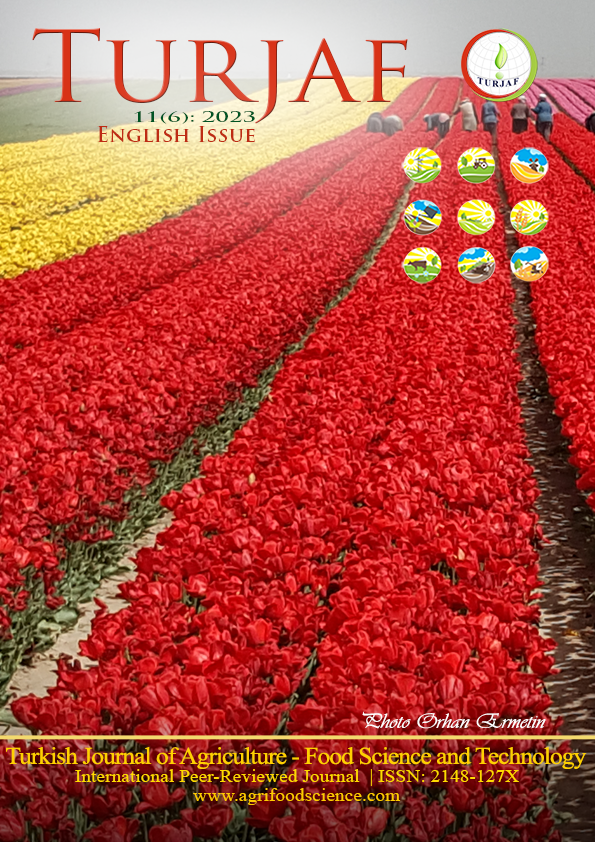Endogeneity Test of Seed on Yield in Nigeria
DOI:
https://doi.org/10.24925/turjaf.v11i6.1116-1121.5760Keywords:
Endogeneity test, seed technology, yield, social capital,Abstract
Researchers treated seed technology and crop yield as exogenous, thereby generating bias estimates. In practice, seed technology increases yield and it’s stimulated by social capital and other factors. This paper develops a choice model of maize-seed exogenously, then tested and corrected for causality. A multistage sampling procedure was adopted using seven Agricultural Development Programme zones drawn from purposively selected Oyo and Osun states. A block each was randomly selected per zone. Twenty-one cells were randomly selected, then data were collected from 385 respondents using a structured questionnaire: Data were analyzed using Ordinary Least Square and Two-Stage Least Square α 0.05. Durbin score chi2(1) = 6.65 (p= 0.009) and Wu-Haussmann F (1,37) = 6.431 (p = 0.012), showed reverse causality that was resolved by the Two-Stage Least Square model. The Two-Stage Least Square result indicated that education (β=-0.53), seed quantity (β=-0.13), seed price (β=-0.08), negatively affected the choice of seed and yield while farm size (β=2.05), fertilizer (β=0.004), herbicide (β=0.22), output-price (β=0.02), meeting attendance index(β=0.02), and improved seed ((β=2.66), had a positive influence. Social capital spurs the use of improved seed, thereby increase maize yield. Consequently, active participation in social groups and the use of improved seed is recommended to increase yield.
References
Achida MB, Garba T, Abdullahi YZ. 2018. Does Social Capital Determine Household Welfare? An Investigation into the Situation in Sokoto Metropolis
Adepoju AA, Oni OA. 2012. Investigating Endogeneity Effects of Social Capital on Household Welfare in Nigeria: A Control Function Approach. Quarterly Journal of International Agriculture 51 (1), pp 3-96
Amare M, Asfaw S, Shiferaw B. 2012. Welfare impacts of maize-pigeonpea intensification in Tanzania. Agricultural Economics 001–1 7
Bailey-serres J, Parker JE, Ainsworth E, Oldroyd GED, Schroeder JI. 2019. Genetic Strategies for Improving Crop Yield. Nature 5757 (781) pp 109-118.
Bollen, KA. 2001 “Two-Stage Least Squares and Latent Variable Models: Simultaneous Estimation and Robustness to Misspecifications.” Ch 7, pp 199138
Bollen KA, Paxton P.1998. Interactions of latent variables in structural equation models. Structural Equation Modeling: A Multidisciplinary Journal, 5, 267-293.
Dei KH. 2017. Assessment of Maize (Zea may) as Feed Resource for poultry. IntechOpen Book Series. https://www.intechopen.com/chapters/52383
Ersado L. 2003. Income Diversification in Zimbabwe: Welfare Implications from Urban and Rural Areas. FCND Discussion Paper 152. International Food Policy Research Institute. Washington, D.C.
FAO. 2009. How to feed the World 2050.Insights from an expert meeting of FAO. OECD Global Forum on Agriculture, Paris, France
FAO. 2017. GIEWS - Global Information and Early Warning System: Country briefs, Nigeria. http://www.fao.org/giews/ countrybrief/country.jsp?code=NGA
Feed the Future and The United State Agency for International Development. 2017. Maximizing Agricultural Revenue and Key Enterprises in Targeted Sites II. Chemonics International Inc
Greene W. 2000. Econometric Analysis 4th Edition. Upper saddle River, New Jersey.
Guilhem B. 2008. Controlling for Endogeneity with Instrumental Variables in Strategic Management Research. Strategic Management Research 6(3): 285–327 Sage Publications (Los Angeles, London, New Delhi and Singapore) http://so.sagepub.com
Gujarati DN. 2003. Basic Econometrics. 4th Edition, McGraw-Hill, New York
Husen NA, Loos TK, Siddig KAH. 2017. Social capital and agricultural technology adoption among Ethiopian farmers. American Journal of Rural Development, 5 (3) pp 65-72
Kaya A, Gözübenli H. 2019. The effect of seed priming on seed vigour and chlorophyll content of maize under saline soil conditions. Cukurova 3th International Scientific Research Congress, October 3-6, Adana/Turkey.
Kaya A, Bostan Budak, D. 2019. Socio-economic structure of maize producing enterprises in AmiK plain. Cukurova 3th International Scientific Research Congress, October 3-6, Adana/Turkey.
Kaya A, Bostan Budak, D. 2022. A survey of Amik plain maize (Zea mays) farmers’ views on drip irrigation. Pakistan Journal of Agricultural Science. 59:319- 327
Komolafe JO, Adeoti IA. 2018. Influence of Social Capital on the Use of Improved Maize Seed among Farmers in Southwestern Nigeria International Journal of Agriculture and Forestry 8(3) pp 129-138
Latruffe L, Piet L. 2013. "Does land fragmentation affect farm performance? A case study from Brittany, France," Working Papers 207854, Institut National de la recherche Agronomique (INRA), Departement Sciences Sociales, Agriculture et Alimentation, Espace et Environnement (SAE2)
Murray MP. 2006. ‘Avoiding Invalid Instruments and Coping with Weak Instruments’, Journal of Economic Perspectives 20(4): 111–32.
Mutanyagwa AP. 2017. "Smallholder Farmers’ Preferences for Improved Maize Seeds Varieties in Tanzania," Research Theses 265536, Collaborative Master’s Program in Agricultural and Applied Economics
Oladejo O, Adefemi J, Ladipo O,Olasupo O. 2012. Supply Analysis for Maize in Oyo and Osun States of Nigeria. International Journals of Life Science and Pharmo Research 2(2) 8-18
Olaniyan AB. 2015. Maize: Panacea for hunger in Nigeria; African Journal of Plant Science 9 (3), pp. 155-174
Olayemi JK. 1998. Elements of Applied Econometrics. Elshaddai Global Ventures. Mokola.
Oyewo IO, Fabiy LY. 2008. Productivity of Maize Farmers in Surulere Local Government Area of Oyo State. International Journal of Agriculture and Rural Development. 1(1) pp 2 25-34
Pesaran MH. Taylor LW. 1999. "Diagnostics for IV Regressions," Oxford Bulletin of Economics and Statistics, Department of Economics, University of Oxford, 61(2), pages 255-281
Stock JH. Watson MW. 2003. Introduction to Econometrics Fourth edition Pearson, Harlow, England
Wooldridge JM. 2003. Further Results on Instrumental Variables Estimation of Average Treatment Effects in the Correlated Random Coefficient Model. In: Economics Letters 79 (2) 13, 185-191
Wooldridge JM. 2006. Introductory Econometrics: A Modern Approach. 3rd Edition, Thomson/South-Western
Yusuf SA. 2008. “Social capital and household welfare in Kwara State”, Nigeria. Journal. hum. ecol., 23(3)
Zeleke BD, Geleto AK, Asefa S, Komicha HH. 2023. The role of social capital in addressing seed access constraints and adoption intensity: Evidence from Arsi Highland, Oromia Region, Ethiopia. Heliyon 9(3).
Downloads
Published
How to Cite
Issue
Section
License
This work is licensed under a Creative Commons Attribution-NonCommercial 4.0 International License.

























